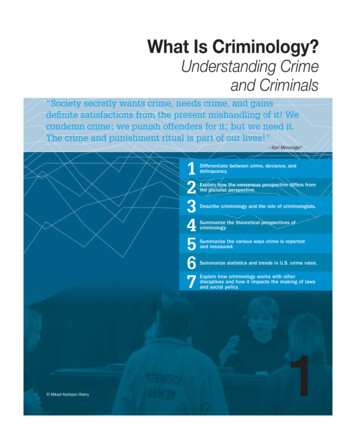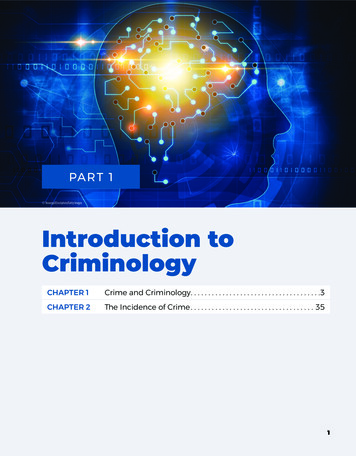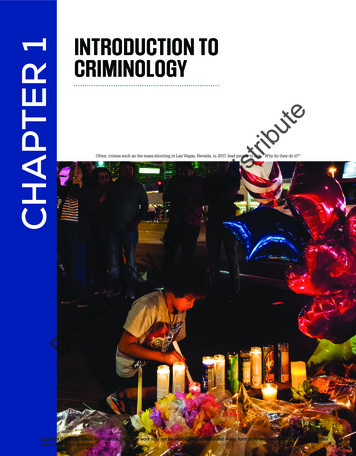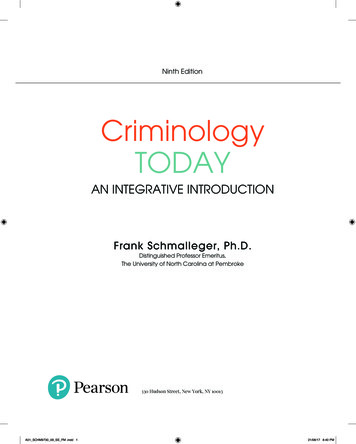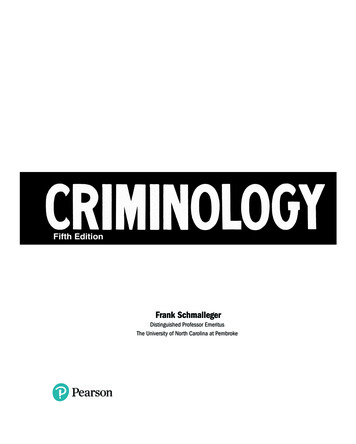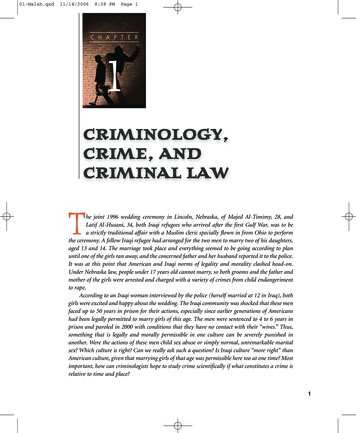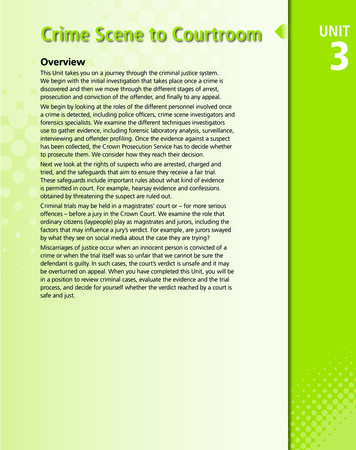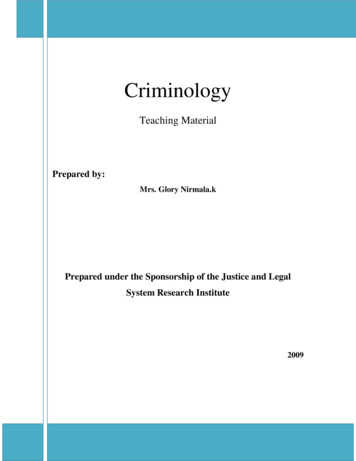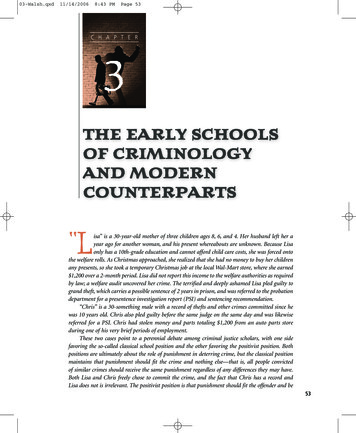
Transcription
03-Walsh.qxd11/14/20068:43 PMPage 53C H A P T E R3THE EARLY SCHOOLSOF CRIMINOLOGYAND MODERNCOUNTERPARTS“Lisa” is a 30-year-old mother of three children ages 8, 6, and 4. Her husband left her ayear ago for another woman, and his present whereabouts are unknown. Because Lisaonly has a 10th-grade education and cannot afford child care costs, she was forced ontothe welfare rolls. As Christmas approached, she realized that she had no money to buy her childrenany presents, so she took a temporary Christmas job at the local Wal-Mart store, where she earned 1,200 over a 2-month period. Lisa did not report this income to the welfare authorities as requiredby law; a welfare audit uncovered her crime. The terrified and deeply ashamed Lisa pled guilty togrand theft, which carries a possible sentence of 2 years in prison, and was referred to the probationdepartment for a presentence investigation report (PSI) and sentencing recommendation.“Chris” is a 30-something male with a record of thefts and other crimes committed since hewas 10 years old. Chris also pled guilty before the same judge on the same day and was likewisereferred for a PSI. Chris had stolen money and parts totaling 1,200 from an auto parts storeduring one of his very brief periods of employment.These two cases point to a perennial debate among criminal justice scholars, with one sidefavoring the so-called classical school position and the other favoring the positivist position. Bothpositions are ultimately about the role of punishment in deterring crime, but the classical positionmaintains that punishment should fit the crime and nothing else—that is, all people convictedof similar crimes should receive the same punishment regardless of any differences they may have.Both Lisa and Chris freely chose to commit the crime, and the fact that Chris has a record andLisa does not is irrelevant. The positivist position is that punishment should fit the offender and be53
03-Walsh.qxd5411/14/20068:43 PMPage 54CRIMINOLOGY: AN INTERDISCIPLINARY APPROACHappropriate to rehabilitation. Lisa and Chris’s crimes were motivated by very different considerations, they are very different people morally, and blindly applying similar punishments to similarcrimes without considering the possible consequences is pure folly.Think about these two cases as you read about classical and positivist thought about humannature, punishment, and deterrence in this chapter.yThe Classical ScholarsModern criminology is the product of two main schools of thought: the classical schooloriginating in the 18th century and the positivist school originating in the 19th century.The early contributors to criminology were amateur dabblers—a mixed bag of philosophers,physicians, lawyers, judges, theologians, and anthropologists whose primary interests lay inpenology (prison management and the treatment of offenders) rather than criminology perse. The study of crime and criminal behavior arose as a secondary consequence of the interestshown by these pioneers in penal reform.You may ask yourselves why a discussion of the “old masters” is necessary; after all, youdon’t see such discussions in physics, chemistry, or biology texts. The reason for this is thatunlike those disciplines, modern criminology is still confronted by the same problems thatconfronted its pioneers, particularly the problem of explaining crime and criminality. Thus,their works are of more than passing interest to us.Preclassical Notions of Crime and CriminalsPrior to the 18th century, explanations of a wide variety of phenomena tended to be of areligious or spiritual nature. Good fortune and disaster alike were frequently attributed to benevolent or malevolent supernatural forces. A simple extension of this worldview was to define crimeas the result of demonic possession or the evil abuse of free will. Because of the legacy of OriginalSin, all human beings were considered born sinners, and so it made no sense to ask questionslike, “What causes crime?” The gift of the grace of God kept men and women on the straight andnarrow, and if they deviated from this line, it was because God was no longer their compass.Demonological explanations of crime began to wane in the 18th century with thebeginning of a period that cultural historians call the Enlightenment, which was essentiallya major shift in the way people began to view the world and their place in it. This newworldview questioned traditional religious and political values, such as absolute monarchyand demonic possession. In their place they substituted humanism, rationalism, and a beliefin the primacy of the natural over the supernatural world. Enlightenment thinkers believedin the dignity and worth of the individual, a view that would eventually find expression inthe law and in the treatment of criminal offenders.The Classical SchoolCesare Beccaria and ReformThe father of classical criminology is generally considered to be the Italian nobleman and professor of law, Cesare Bonesana, Marchese di Beccaria. In 1764, Beccaria published what was tobecome the manifesto for the reform of judicial and penal systems throughout Europe—DeiDelitti e della Pene (On Crimes and Punishment).1 The widespread acclaim of this book among
03-Walsh.qxd11/14/20068:43 PMPage 55Chapter 3 The Early Schools of Criminology and Modern Counterpartsintellectuals eventually led to its acceptance by thelegal and political authorities. The book is animpassioned plea to humanize and rationalize thelaw and to make punishment more just and reasonable.Beccaria’s humanist philosophy stood insharp contrast to the treatment of criminals at thetime, which included torture for all manner ofoffenses, for the extraction of statements fromsuspects, and even at times from witnesses. Judgesof the period often levied vicious and arbitrarypenalties against convicted criminals, with theharshness of punishment often based on therespective social positions of offenders and victims and on a judge’s penchant for mercy or cruelty. Public punishment was viewed both as socialvengeance and as a means of instilling a deterrentfear into the population; the crueler the punishment, the greater its deterrent effect was assumedto be.Beccaria did not question the need for punishment, but he believed that laws should bedesigned to preserve public safety and order, notto avenge crime. He also took issue with the common practice of secret accusations, arguing that Photo 3.1 Cesare Beccaria (1738–1794)such practices led to general deceit and alienationin society. He argued that accused persons shouldbe able to confront their accusers, know the charges brought against them, and enjoy the benefit of a public trial before an impartial judge as soon as possible after arrest and indictment.If offenders are found guilty, punishment should fit the crime (i.e., be proportionate tothe harm done to society), be identical for identical crimes, and be applied without referenceto the social status of either the offender or the victim. Beccaria championed not only the abolition of the death penalty but also the cause of merciful punishments, which he believedshould only minimally exceed the level of damage done to society. Punishment, however, mustbe certain and swift to make a lasting impression on the criminal. To ensure a rational and fairpenal structure, punishments for specific crimes must be decreed by written criminal codesand the discretionary powers of judges severely curtailed. The judge’s task was to determineguilt or innocence and then to impose the legislatively prescribed punishment if the accusedis found guilty.Jeremy Bentham and Human NaturePerhaps an even more prominent figure of the classical school was British lawyer and philosopherJeremy Bentham, a contemporary and an admirer of Beccaria. In the English-speaking world,Bentham’s legacy extended beyond the reformation of the criminal law to embrace police andcorrectional reforms.2 His major work, A Fragment on Government and an Introduction to thePrinciples of Morals and Legislation,3 is essentially a philosophy of social control based on the55
03-Walsh.qxd5611/14/20068:43 PMPage 56CRIMINOLOGY: AN INTERDISCIPLINARY APPROACHprinciple of utility, which prescribed “thegreatest happiness for the greatest number.”The principle posits that any human action atall should be judged moral or immoral by itseffect on the happiness of the community.Thus, the proper function of the legislature isto promulgate laws aimed at maximizing thepleasure and minimizing the pain of the largestnumber in society—“the greatest good for thegreatest number.”4 Having its basis in the natural human need for happiness, the principleof utility can be seen as a principle of naturallaw.If legislators are to legislate according tothe principle of utility, they must understandhuman motivation, which for Bentham waseasily summed up as follows: “Nature hasplaced mankind under the governance of twosovereign masters, pain and pleasure. It is forthem alone to point out what we ought to do,as well as to determine what we shall do.”5This was essentially the Enlightenment concept of human nature, which was seen ashedonistic, rational, and endowed with freewill. The classical explanation of criminalbehavior—and even how to prevent it—canbe derived from these three assumptions Photo 3.2 Jeremy Bentham, often credited as theabout human nature.founder of University College London, insisted that his body beHedonism is a doctrine with the centralput upon display there after his death. You can visit a replica oftenet that the achievement of pleasure orit today.happiness is the main goal of life. We don’thave to learn to be hedonistic; pleasure isintrinsically desirable, and pain is intrinsically undesirable. All other life goals are seen only as instrumentally desirable; that is, they areonly desirable as means to the end of achieving pleasure or avoiding pain. Thus, hedonism isthe greatest single motivator of human action.Rational behavior is behavior that is consistent with logic. People are said to behave rationally when we observe a logical “fit” between the goals they strive for and the means they useto achieve them. Rationality is not to be confused with morality. Crime is rational (at least inthe short run) if the criminal employs reason and acts purposely to gain desired ends. The goalof human rationality is self-interest, and self-interest governs our behavior whether in conforming or deviant directions.Hedonism and rationality are combined in the concept of hedonistic calculus, a methodby which individuals are assumed to logically weigh the anticipated benefits of a given courseof action against its possible costs. If the balance of consequences of a contemplated action isthought to enhance pleasure and/or minimize pain, then individuals will pursue it; if not, they
03-Walsh.qxd11/14/20068:43 PMPage 57Chapter 3 The Early Schools of Criminology and Modern Counterpartswill not. If people miscalculate, as they frequently do, it is because they are ignorant of the fullrange of consequences of a given course of action, not because they are irrational.Free will enables human beings to purposely and deliberately choose to follow a calculated course of action. If people seek to increase their pleasures illegally, they do so freely andwith full knowledge of the wrongness of their acts. Given this knowledge, society has a perfectly legitimate right to punish those who harm it.It follows from the classical assumptions about human nature that if crime is to be deterred,punishment (pain) must exceed the pleasures gained from the fruits of crime. Hedonistic andrational criminals will weigh the costs against the benefits of crime and desist if, on balance, thecosts exceed the benefits. Estimations of the value of various pleasures and pains are to be considered with reference to four circumstances: intensity (severity), duration, certainty, andpropinquity (how soon after the crime that pleasure or pain is forthcoming).6The Legacy of the Classical SchoolThe classical school of criminology, so called because its mode of inquiry was the armchair philosophy practiced by the ancient “classical” Greek philosophers,7 was a school of philosophicaljurisprudence bent on establishing a set of reformist moral values in criminal justice, not aschool of empirical data collection and analysis attempting to build a theory of criminality.Regardless of their influence on criminological theory, the influence of the classical theorists onthe legal and penal systems of Europe and North America is immeasurable. Many Europeanmonarchs (the “Enlightened Despots”) of the 18th century were moved to adopt their principles, and the American Constitution and the 1789 French Declaration of the Rights of Man werevery much influenced by them.8 All modern criminal justice systems in the world assume theclassical position that persons are free agents who deserve to be punished when they transgressthe law. We may also recognize many of the ideas championed by Beccaria in such rights as freedom from cruel and unusual punishment, the right to a speedy trial, the prohibition of ex postfacto laws, the right to confront one’s accusers, and equality under law, contained in the U.S. Billof Rights and other documents at the heart of Western legal systems today. The emphasis onrationality, on free will, and on personal responsibility within the modern legal system reflectsthe once radical image of human beings posited by the great Enlightenment thinkers.yThe Rise of PositivismWhat Is Positivism?Classicists tended to define criminal acts as natural consequences of the unrestrained humantendency to seek pleasure—as simply hedonistic abuses of free will. The problem with such anexplanation, if accepted without qualification, is that it provides little possibility of further investigation. In the 19th century, criminologists began to move away from the classical assumptions,especially the assumption of free will as it is commonly understood, and toward a more scientific view of human behavior. This is not to say that hedonism, rationality, and free will are mythical human attributes. They may, in fact, define the “essence” of human nature, but to acceptthese constructs in pure form poses great difficulties for science, a method of inquiry that seeksmeasurable “causes” of the phenomena it explores. The increasingly popular view among criminologists of this period was that crime resulted from internal and/or external forces impinging57
03-Walsh.qxd5811/14/20068:43 PMPage 58CRIMINOLOGY: AN INTERDISCIPLINARY APPROACHon individuals, biasing or even completely determining their behavioral choices. This positionbecame known as determinism, and its adherents were known as positivists.Just as the spirit of rationalism in the 18th century ushered in the classical school, thespirit of science in the second half of the 19th century ushered in the positivist school. Theterm positivism is used to designate the extension of the scientific method—from which morepositive knowledge can be obtained—to social life. Positivists in the human sciences insistedon divorcing science from metaphysics and morals and looking only at what is, not whatought to be. The writings of natural scientists, particularly those of Charles Darwin on evolution, generated a major new way of thinking about human nature among intellectuals just asrevolutionary as the writings of the Enlightenment philosophers a century earlier. The flattering image of human beings that emerged from the Enlightenment gave way to the evolutionary view that we are different only in degree from other animal forms and that science couldexplain human behavior just as it could explain events in the nonhuman world. Positivistcriminologists were more concerned with discovering biological, psychological, or socialdeterminants of criminal behavior than with the classical concerns of legal and penal reforms.Enrico Ferri, one of the early positivists, gives us perhaps the best short descriptionof the differences between classical and positivist criminologists. Note that even back then,criminologists from different schools of thought were taking jabs at one another: “We areempirical scientists; you lot are just armchair speculators”:For [the classicists] the facts should give place to syllogisms [reasoning from a takenfor-granted premise to a logical conclusion]; for us [positivists] the facts govern and noreasoning can occur without starting from the facts. For them science only needs paper,pen, and ink and the rest comes from a brain stuffed with . . . abundant reading ofbooks. . . . For us science requires spending a long time in examining the facts one byone, evaluating them, reducing them to a common denominator, [and] extracting thecentral idea from them. For them a syllogism or an anecdote suffices to demolish amyriad of facts gathered by years of observation and analysis; for us, the reverse is true.9A Bridge Between the Classical and Positivist SchoolsThere is not always the sharp discontinuity between the classical and positivist schools that weare sometimes led to believe. For instance, although traditionally placed firmly in the classicalcamp, the work of Jeremy Bentham may be considered a bridge between the two schools.Despite Bentham’s classical view of human nature, he never lost sight of its intricacies. Whilealways maintaining the freedom of the will, he argued that it was moved by “motives” arisingfrom the “bodily senses,” which were differentially felt by people according to certain internaland external factors. He devoted an entire chapter of A Fragment on Government to 32 biological, psychological, and social factors (e.g., intelligence, temperament, personality, gender, age,education, occupation) that he thought of as “circumstances influencing sensibility.”10 Althoughhe only devoted a single paragraph to each one, the fact that he recognized internal and external constraints on free will and rationality leads us to believe that Bentham may have been boththe last of the old classical criminologists and the first of the positivist criminologists.Cartographic CriminologySome of the earliest positivist attempts to leave the armchair and collect facts about crime tounderstand it came from cartographers. Cartographers are scholars who employ maps and
03-Walsh.qxd11/14/20068:43 PMPage 59Chapter 3 The Early Schools of Criminology and Modern Counterpartsother geographic information in their research, and those who employ these methods to studycrime are called cartographic criminologists. Rather than exploring why individuals commitcrimes, cartographic criminologists are more interested in where and when criminal behavioris most prevalent.The first publication of detailed statistics relating to criminal activity for an entirecountry occurred in France in 1827, more than 100 years before the publication of the firstedition of the Uniform Crime Reports (UCR) in the United States. This work was used by twoscholars to make statements about crime and its causes that anticipated by about a centurythose of two theories we will explore in the next chapter. Two scholars used this work to makestatements about crime and its causes. They were prescient in that they made statements relevant to crime causation that would be made 100 years later. The first was a Frenchmannamed Andre-Michel Guerry, and the other was a Belgian named Lambert-Adolphe-JacquesQuetelet. Quetelet compared crime rates in France across ages, sexes, and seasons. He saw thesame reflections in his data that we see today in the American UCR—that is, young malesliving in poor neighborhoods commit the most crime. He thought sociologically about crimebefore the discipline officially existed, writing that “society prepares the crime and the guiltyis only the instrument by which it is accomplished.”11Both Quetelet and Guerry discounted the idea that crime is caused by poverty, notingthat the wealthiest regions of France had the greatest level of property crimes. However,Guerry noted that the level of wealth in a region does not necessarily correspond to the levelof wealth among all its citizens and that being poor amid riches (as in urban France), notbeing poor per se (as in rural France), is the condition that produces the most “misery”(today we call this relative deprivation). He also noted that among the factors affecting crimeare areas “where a frequent mixture of people takes place, and where the inequality of fortune is most felt.”12Guerry produced many fine-shaded ecological maps to represent crime rates in differentareas. This method of presenting data crossed the English Channel to influence Britishresearchers Henry Mayhew and Joseph Fletcher. Using British crime data from the 1830s to1840s, both men independently mapped out the concentration of various kinds of criminalactivity across England and Wales, as well as other factors such as population density and ratesof illegitimacy. They came to many of the same conclusions that U.S. researchers would latercome to (i.e., crime and delinquency are concentrated in poor neighborhoods undergoingpopulation changes). Many British cities were experiencing the same demographic changes inthe early 1800s that American cities were to experience in the early 1900s. Rural people flockedto the big cities to obtain work in the new factory system, and in the obscurity of these citiesof strangers, social bonds weakened, morals declined, and crime flourished.13Given the many conclusions of the cartographic school that are consistent with manymodern criminological positions, it is surprising that more attention is not paid to it. Theinfluence of the school declined in the latter part of the 19th century as interest started tofocus more on the individual criminal and less on his or her environment. It would reemergein the Chicago in the early 20th century as human ecology.Biological Positivism: Cesare Lombroso and the Born CriminalFive years after Charles Darwin shocked the world with the publication of his theory of evolution, an Italian army psychiatrist named Cesare Lombroso published Criminal Man,14 which isconsidered the first book devoted solely to the causes of criminality ever written. Lombroso is59
03-Walsh.qxd60 11/14/20068:43 PMPage 60CRIMINOLOGY: AN INTERDISCIPLINARY APPROACHwidely acclaimed as the father of modern criminology, although he is often criticized for the viewsput forth in his book. His basic idea was that many(not all, as is commonly assumed) criminals areborn criminal and that they are evolutionary“throwbacks” to an earlier form of life. The termused to describe the appearance of organismsresembling ancestral (prehuman) forms of life isatavism. Lombroso was influenced by ErnstHaeckel’s famous biogenetic law, which stated thatontogeny (individual development) recapitulatesphylogeny (evolutionary development of thespecies).15 Criminals were thus “throwbacks” to amore primitive stage of evolution and could beidentified by a number of measurable physicalstigmata. These stigmata included protrudingjaws, drooping eyes, large ears, twisted and flatishnoses, long arms relative to the lower limbs, sloping shoulders, and a coccyx that resembled “thestump of a tail.”16The concept of atavism highlights an imporPhoto 3.3 Cesare Lombroso (1836–1909)tant point of difference between the classical andpositivist schools: While the classicists viewedcriminals and noncriminals as essentially similar beings who simply chose different pathways,positivists viewed them as being quite different beings. Lombroso was just one of many whosought to understand behavioral phenomena with reference to the principles of evolution asthey were understood at the time. If humankind was just at one end of the continuum of animal life, it made sense to many people that criminals—who acted “beastly” and lacked reasoned conscience—were biologically inferior beings.In addition to the atavistic-born criminal, Lombroso identified two other types: theinsane criminal and the criminaloid. Although insane criminals bore some stigmata, theywere not born criminals; rather, they become criminals as a result “of an alteration of thebrain, which completely upsets their moral nature.”17 Among the ranks of Lombroso’s insanecriminals were alcoholics, kleptomaniacs, nymphomaniacs, and child molesters. Criminaloidshad none of the physical peculiarities of the born or insane criminal and were considered lessdangerous. Criminaloids were further categorized as habitual criminals, who become so bycontact with other criminals, the abuse of alcohol, or other “distressing circumstances”; juridical criminals, who fall afoul of the law by accident; and the criminal by passion, hot-headed andimpulsive persons who commit violent acts when provoked.Although Lombroso is best remembered for his concept of the atavistic-born criminal,his later work, Crime: Its Causes and Remedies,18 listed a bewildering variety of possible“causes,” including unlikely candidates such as tobacco, hair color, and “goitrous districts.”Notwithstanding Lombroso’s recognition that crime has multiple causes, he still argued that“organic causes” accounted for 35% to 40% of the “fatal influence” on crime.19Perhaps it is because of this latter point that Lombroso has been reviled and ridiculed asa biological determinist. Some criminologists, while acknowledging Lombroso’s many errors
03-Walsh.qxd11/14/20068:43 PMPage 61Chapter 3 The Early Schools of Criminology and Modern Counterparts61 Photo 3.4 This porcelain head for salein a New Orleans antique store shows thesections of the brain, as detailed by19th-century phrenologists. They believedthat each section was responsible for a particular human personality trait. If a section wereenlarged or shrunken, the personality wouldbe likewise abnormal. Doctors, particularlythose doing entry examinations at Americanprisons, would examine the new inmate’s headfor bumps or cavities to develop a criminalprofile. For example, if the section of brainresponsible for “acquisitiveness” wasenlarged, the offender probably was a thief.Lombroso and his school combined phrenologywith other models that included externalphysical appearance traits that could singleout criminals from the general population.in logic, research design, measurement, and elitist and sexist ideas, insist that his contributionsare both misunderstood and undervalued. His methodology, although very badly flawed bymodern standards, was an improvement over previous attempts at positivistic criminology.20From Lombroso on, there has been an enduring commitment to sort, sift, and measure allsorts of physical, psychological, economic, and social phenomena in an attempt to get to thebottom of crime and criminality.FOCUS ON . . .Lombrosoism Before and After LombrosoThere have always been those for whom human character and personality are transparent inphysical appearance. In Shakespeare’s play, Julius Caesar distrusts Cassius because he “has alean and hungry look.” Such folk wisdom was systematized almost 300 years before the publication of Cesare Lombroso’s Criminal Man by another Italian physician, Giambattista della Porta,who developed a theory of human personality called Physiognomy. Porta claimed that the study ofphysical appearance, particularly of the face, could reveal much about a person’s personality andcharacter. Thieves, for instance, were said to have large lips and sharp vision.(Continued)
03-Walsh.qxd6211/14/20068:43 PMPage 62CRIMINOLOGY: AN INTERDISCIPLINARY APPROACH(Continued)Almost 200 years later, Johann Kasper Lavater published his three-volume Essays onPhysiognomy, which was highly acclaimed in medical and scientific circles. Lavater went further thanPorta in claiming that the “higher” character of the English aristocrat and the “lower” character ofthe London thief could be discerned simply from a detailed study of their faces. In a similar vein,Hubert Lauvergne’s 1844 study of French convicts concluded that they had faces that easily revealtheir “brutal and impassible (incapable of feeling) instincts.” Lauvergne’s descriptions of the facialfeatures of convicts (massive jaws and receding foreheads) conjured up the same ape-like imagethat Lombroso’s descriptions would 32 years later.Lauvergne was a student of Franz Josef Gall, the founder, along with John Spurzheim, of another exoticsystem of assessing character from physical features called phrenology. Phrenologists claimed that the contours of an individual’s skull revealed his or her psychic makeup. The basic idea was that various cognitivefunctions are localized in the cerebral cortex (the thinking part of the brain). Parts of the cortex regulating themost dominant functions were thought to be bigger than parts regulating the less dominant ones. Thus, therelative sizes of a person’s cranial bumps pointed to the relative strengths of his or her personality and character. Criminals were said to have cranial maps showing large protuberances in parts of the cortex thoughtto regulate craftiness, brutishness, moral insensibility, and so on, as well as small bumps in such “localities”as intelligence, honor, piety, and so forth. Thus the measure (or is it the “mismeasure”?) of humanity had arather long history predating Lombroso. Lombroso occupies his place in criminology because his work wassolely criminological; the works discussed here are more general works having little influence on criminology.Some late-20th-century criminologists have renewed interest in possible connections betweenphysical appearance and criminal behavior. A survey of inmates in New York found that about halfof them had at least a moderate degree of disfigurement other than tattoos,21 and a review ofthe literature on the subject concluded that prisons house a disproportionate number of disfiguredmales.22A 1993 article examined what are called minor physical anomalies (MPAs) and t
Think about these two cases as you read about classical and positivist thought about human nature, punishment, and deterrence in this chapter. y The Classical Scholars Modern criminology is the product of two main schools of thought: the classical school originating in the 18th century a
